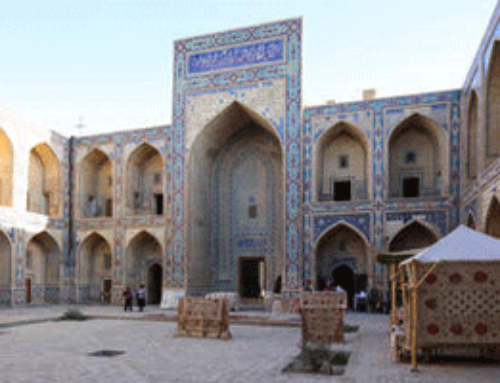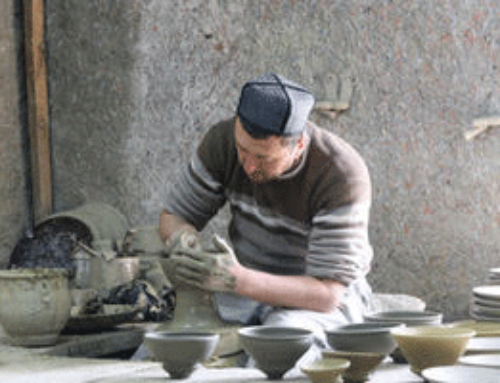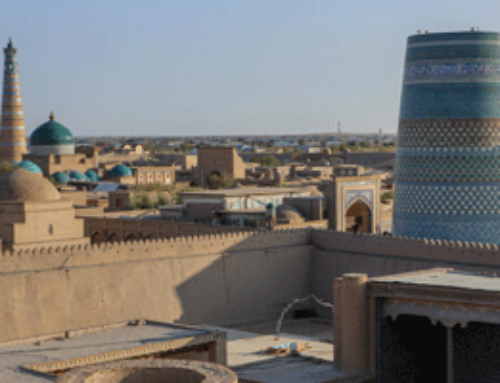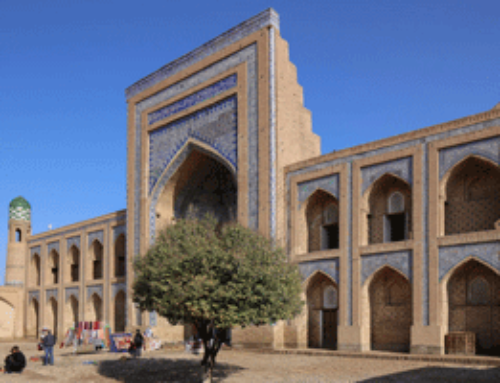The tour includes the following cities:
Tashkent, Samarkand, Pendjikent (Tajikistan), Nurata, Yangiqazgan, Bukhara, Khiva, Nukus
15 Day Explorer Tour throughout Uzbekistan
Day 1. Tashkent.
You will be met in Tashkent at the airport as you arrive late in the evening. You will be transferred to your hotel for your first overnight. (1st of 2 nights).
Day 2. Tashkent.
This morning you will visit the Khast-Imam Square, the old quarter of Tashkent where you will see an 8th century Koran which was brought to Central Asia by Tamerlane in the 15th century. On the square you will also see some glorious buildings and beautiful turquoise-tiled domes lighted like an exotic stage set.
Later you will visit the Museum of Applied Arts to see magnificent suzanis (embroidered panels) and other fine crafts, the Abdul-Khasim Madrassah (Islamic school) with its hujra (student dormitories) which are now used as metalwork craft workshops producing jewelry, miniature paintings, papier-mâché lacquered boxes and other goods.
After lunch at an excellent local restaurant, you’ll visit the Chor-Su Market – the biggest market in Tashkent. You will walk through the market and see rows of artisans making craft items for daily needs, the place where dairy products and dry cheese are sold, the butchers’ area, the market for fresh fruits and vegetables, the bread bakeries, and the “food court” of freshly made lunches where people can order their meal and eat on site.
Later you will experience the Tashkent subway (Metro). Tashkent metro stations are among the most beautiful in the world and are among the top attractions in the city. Tashkent’s metro was the seventh in the USSR, built after the 1966 earthquake. The first line opened in 1977 and two more lines followed. For years you could not take pictures of the interior of metro stations, because of their military and strategic functions. In fact, some of the Tashkent metro stations serve as a nuclear bomb shelters as well. Almost every subway station in Tashkent is fascinating. They all have their own unique architectural features and artistic elements. Some look like ballrooms with huge chandeliers hanging from the ceiling while others look like film sets from science fiction movies. Dinner and overnight in Tashkent. (2nd of 2 nights).
Day 3. Tashkent – Samarkand.
In the morning you will drive to Samarkand, the grand capital of the emperor Tamerlane (the brilliant and great 15th century ruler who created a huge empire which spanned from Western China to Eastern Europe, including Persia, Turkey, and the Caucasus. Tamerlane made Samarand as his Imperial Capital).
The famous Silk Road traversed through Tashkent, the Sirdarya regions and the mountainous countryside of the Jizzah region. You will have lunch in a picturesque roadside choi-khona (Tea House/Café).
After arriving and checking into the hotel, the sightseeing program in Samarkand will begin.
You will be driven out to see the Shaki-Zinda ensemble of the Mausoleums. This unusual necropolis has monuments from the 14th and 15th centuries, reflecting the development of the monumental art and architecture of the Timurid dynasty.
The name Shakhi-Zinda (meaning “The living king”) is connected with the legend that Kusam-ibn-Abbas, a cousin of the prophet Muhammad, is buried here. He came to Samarkand with the Arab invasion in the 7th century to preach Islam. Popular legends recount that he was beheaded for his faith, but he didn’t die. It is believed that he took his head and went into a deep well (the Garden of Paradise), where he’s still living now.
The Shakhi-Zinda complex was formed over eight centuries (from the 11th till 19th) and now includes more than twenty buildings. The ensemble comprises three groups of structures: the lower, middle and upper, connected by four-arched domed passages locally called chartak. The earliest buildings date back to the 11-12th centuries. Of the tombstones, mainly their bases and headstones have remained. The majority of the monuments date back to the 14-15th centuries. Dinner and overnight in Samarkand. (1st of 3 nights).
Day 4. Samarkand.
After breakfast a visit will be paid to the most magnificent architectural complex in the whole of Uzbekistan – Registan Square. It is a breath-taking masterpiece construction, comprised of three sparkling tile madrassahs built in the 14th – 16th centuries. Tamerlane is quoted as having said “Let our enemies know our strength by witnessing the supremacy of our architecture”. Continue the sightseeing program to the glistening Gur-Emir Mausoleum, where Tamerlane is buried. The beauty and elegance of the interior of this mausoleum will astound you.
You will then visit a paper making workshop located in a nearby village. The paper is made from the bark of mulberry trees. This craft was widespread in the Samarkand area in 16th – 19th centuries. When factory made paper arrived at the end of 19th century however, this craft died and was nearly forgotten.
After a delicious lunch you will visit Bibi-Khanum, the remains of the largest and most magnificent mosque in Samarkand, and once the entire Islamic world. Built in the 16th century this mosque is one of the most important monuments of Samarkand. By the mid 20th century however, only a grandiose ruined bit of it still survived. Fortunately, major parts of the mosque were restored during the Soviet period.
After his Indian campaign in 1399 Timur (Tamerlane) decided to undertake the construction of a gigantic mosque in his new capital, Samarkand. From the beginning of the construction, problems of structural integrity revealed themselves. Various reconstructions and reinforcements were undertaken in order to save the mosque. However, after just a few years, the first bricks had begun to fall out of the huge dome over the mikhrab (the niche indicating the direction to Mecca). The scale of Timur’s plans pushed the building techniques of the time over their limit, and the building’s integrity was not helped by the rushed nature of its construction.
Continue to the nearby Siyob Market (or Bazaar) adjacent to the Bibi-Khanym Mosque. It is the largest bazaar in Samarkand. All daily necessities, such as “Samarkand naan” (bread), are sold in this bazaar which is visited not only by local people but also by domestic and foreign tourists.
Then you will see the remains of the medieval world’s best and most remarkable observatory developed by Tamerlane‘s brilliant and learned grandson, Ulugbek. Although originally part of a three-story observatory and a 30 meter-high (90 feet) marble astrolabe for observing the positions of the stars, only the astrolabe’s under-ground semicircular track remains.
Ulugbek discovered 200 previously unknown stars with this instrument, and his calculations as to the length of the year have been shown to be amazingly accurate. In the small museum next door you will learn more about Uzbek astronomers.
In the early evening you’ll visit a silk carpet weaving workshop run by an Afghan family. See how local craftspeople create age-old, colorful and complex patterns using silk and wool yarns. Dinner and overnight in Samarkand. (2nd of 3 nights).
Day 5. Samarkand – Pendjikent – Samarkand.
Today will include a day trip to Penjikent (Tajikistan) – the gateway to the beautiful Fan Mountains of Tajikistan. Ancient Pendjikent was a small but flourishing town of the Sogdians (the ancient name of people living in the territory of current Uzbekistan, Tajikistan, Kazakhstan, and Kyrgyzstan) in pre-Islamic Central Asia. The name of town could be translated as “five towns” in Persian.
By the 5th century AD Penjikent became a very well developed place. In 722 AD the Arab forces besieged and took the town. The last ruler of the town Divashtich fled into upper Zarafshan but he was captured and sentenced to death. For around 50 years, ancient Pendjikent was ruled by new administrators but towards the end of the 8th century the town was depopulated and relocated. Many ancient ruins of the old city, particularly the city architecture and works of art remain today. The original town’s ruins have never built upon, leaving an intriguing excavation site for the travelers.
Dinner and overnight in Samarkand. (3rd of 3 nights).
Day 6. Samarkand – Nurata.
After breakfast you will drive on to Nurata, once known as Nur, this ancient town held a strategic position on the frontier between the cultivated lands and desert. Nurata has retained some of the holy sites that attracted pilgrims from all over Central Asia. The ruins of a hilltop citadel in the town center near the bazaar mark Nurata’s history and are said to have stood before the arrival of Alexander the Great. Below is the main pilgrimage site, the Chashma (spring), miraculously formed when Hazrat Ali – the prophet Mohammed’s son-in-law struck the ground with his walking staff. Hundreds of holy fish swim protected and unharmed in mineral packed water. The mosque for visiting pilgrims dates back to the 10th century and subsequent reconstructions have preserved the roof of 25 cupolas. An adjacent museum details local history and culture through tools, clothes and ceramics.
You will spend the evening with a local family, being immersed in the culture and lifestyle.
Day 7. Nurata – Yangiqazgan yurt camp.
After breakfast you will venture into the desert for a day of camel riding, a centuries-old mode of Central Asian transport. You will meet semi-nomadic people living in the desert and learn about their contemporary lifestyle. You will spend a magical night in an authentic yurt camp, relaxing around a campfire under a crystal-clear dome of stars.
Day 8. Yangiqazgan yurt camp – Bukhara.
After breakfast and some more camel riding depart Yangiqazgan to visit Aydarkul Lake (about 250 km long) and continue on to holy Bukhara.
On the way you will see the ruins of the Rabat-Malik Caravansaray (an Inn for caravans); constructed along the Silk road in 11th century according to the orders of a son of one of Samarkand’s rulers. The portal of the caravansaray is one of the most ancient among the Central Asia portals. It has an inscription engraved by unknown masters which reads “the monument was built by the Sultan of the World and this ruinous place (the Malik Steppe territory) became well-furnished…”.
100 meters (300 feet) from the caravansaray there is a giant dome covered tank named Sardoba Malik. This is a 13 meters (40 feet) diameter storage reservoir which was built in the 11th century specifically to supply the Rabat-Malik Caravansaray with water. Water to the tank was fed by the Zaravshan River through an underground canal and was kept there for the whole summer. The water there was clean and cold owing to the dome, protecting it from the heat of the sun.
Stop in Gijduvan to visit the most important ceramic center of the Bukhara region. If you are lucky, you’ll have the opportunity to see the centuries old tradition of using a donkey for turning the millstones during the process of grinding natural dyes. Lunch will be at a local potter’s home. Continue on an afternoon drive to Bukhara for a late afternoon arrival.
Dinner and overnight in Bukhara. (1st of 3 nights).
Day 9. Bukhara.
Today you will experience a tour beginning from the remarkable architectural masterpiece, the Ismail Samani Mausoleum, dating from the early 10th century. This Mausoleum is located in the North-Western part of Bukhara, just outside its historic center. The mausoleum is considered one of the iconic examples of early Islamic architecture and is known as the oldest funerary building of Central Asia. This mausoleum is in extraordinarily good condition as it was protected for centuries having been hidden by the cemetery tombs which encroached upon it tightly. It was built as the resting place of the powerful and influential Islamic Samani family dynasty which ruled from approximately 900 to 1000 AD. The Samanids established their de facto independence from the Abbasid Caliphate in Baghdad and ruled over some areas covered by the modern day countries of Iran, Afghanistan, Uzbekistan, Tajikistan, and Kazakhstan.
Perfectly symmetrical, compact in its size, yet monumental in its structure, the Mausoleum not only combined multi-cultural building and decorative traditions, such as Sogdian, Sassanian, Persian and even Classical, but also introduced the squinch, an innovative dome support solution. It also incorporated features customary for medieval Islamic buildings – circular domes and mini domes, pointed arches, elaborate portals, columns and intricate geometric designs.
The Bolo-Khauz Mosque built by order of the Emir of Bukhara in the 17th century will be the next stop on your Bukhara tour. This historical mosque was built on the opposite side of the citadel of the Ark in the Registan district. It served as a Friday mosque during the time when the emir of Bukhara was being subjugated under the Bolshevik Russian rule in 1920s. Thin columns made of painted wood were added to the frontal part of the iwan (terrace) built in 19th century, additionally supporting the roof of the summer prayer room. The columns are decorated with colorful muqarnas (stalactites).
Your tour will include a visit to the 2000 year-old massive Ark (Fortress) where the Bukhara Emirs once lived. In addition to being a military structure, the Ark encompassed what was essentially a town that, during much of the fortress’ history, was inhabited by the various royal courts that held sway over the region surrounding Bukhara. The Ark was used in this manner until it fell to Russia in 1920. Currently, the Ark is an attraction for visitors and houses museums covering its history.
After lunch continue your sightseeing to visit Poi-Kalon, or “Pedestal of the Great”, the heart and focal point of all Bukhara. You will also visit the madrassahs of Ulug-Bek and Abdul-Aziz Khan and the 16th century Magoki-Attori mosque, dating from 12th century. Your visit will include the Lyabi-Khaus (otherwise known as the Shore of the Pool), an architectural complex consisting of a 16th century madrassah and a mosque and the nearby dome covered markets. During its history, over 300 mosques (large and small) have been built in Bukhara, many of which still remain.
In the evening enjoy a concert program at the Nodir-Divan Begi Madrassah. The program includes Uzbek national music and dance combined with a fashion show of contemporary garments made of traditional textiles. Dinner and overnight in Bukhara. (2nd of 3 nights).
Day 10. Bukhara.
Today you will be driven 12 km. into the countryside to begin a sightseeing visit at the Memorial Complex of Bakhouddin Naqshbandi, one of the most important Muslim shrines. Every self-respecting Muslim knows and reveres the name of this great theologian of the 14th century, and founder of the Sufi Order “Naqshbandia”.
Bakhouddin Naqshbandi appealed to people to be modest and reject luxury. His philosophy was based on the principle: “Dil ba joru, dast ba kor” (“The heart should be with the God, and hands at work”). The main building of the complex is the khanqah (dormitory for dervishes). In front of the mosque there is a minaret and small madrassah. In a separate courtyard there is a large necropolis, where Naqshbandi is buried. The Mausoleum of Bakhouddin Naqshbandi is considered to be the Central Asian Mecca. Believers from different Islamic countries come here to ask for the fulfillment of wishes and healing.
Continue to the Sitorai Mohi Hosa (Palace of Moon-like Stars), the former summer residence of the last khan, which is now the Museum of Decorative Applied Arts. The palace was built in the beginning of 20th century by Russian architects and local artisans. You will observe interesting examples of delicate traditional filigreed plaster designs over mirrored walls and dainty painted floral interior plaster decorations, as well as huge banquet halls. Of particular interest is a large collection of historic costumes, including paranjas (black horse hair facial veils) and heavy outer garments decreed to preserve the modesty of women, as well as a fine collection of Ming china and lovely silver.
You will complete the program in the early afternoon to provide you time to explore Bukhara yourselves. Dinner and overnight in Bukhara. (3rd of 3 nights).
Day 11. Bukhara – Khiva.
After breakfast embark on a 500 km. drive to Khiva (a 7-8 hour drive). Khiva is a remote desert city and the last great oasis on the old caravan route that runs through the Kizil-Kum (Red Sands) desert. Lunch en route. Arrival in Khiva in the late afternoon for dinner and overnight.
(1st of 2 nights).
Day 12. Khiva.
Today you will explore the UNESCO protected “open-air museum” thick clay walled city of Khiva, called the Ichan-Qala (Inner City). This fortress city housed thousands of people for centuries and has an astounding number of sights per square meter; the most homogenous collection of architecture in the Islamic world.
As you wander on a walking sightseeing tour of Khiva through this ancient maze of winding alleys and clay buildings that has been ideally preserved and hardly changed over the course of the centuries, you will sense the atmosphere of the old city. Khiva has retained its medieval feel, though there are people living inside its walls to this day. It will be easy to imagine the ways that merchants and residents must have walked through the same streets as you yourself.
You will visit a number of outstanding buildings including the Kalta-Minor Minaret, a stubby, unfinished minaret decorated with intricate blue tiles, and the unique Juma Mosque, whose ceiling is supported by 213 wooden columns, each carved uniquely with different designs.
You will also be taken to visit other of the most interesting historical sites of the city such as: the Kunya-Ark Citadel, the Tash-Khovli Palace, the Mukhammad-Aminkhan Madrassah, the Mukhammad Rahimkhan Madrassah, the Pakhlavan Makhmud Mausoleum, the Minaret of Islam-Khodja, the Museum of Applied Arts, and different workshops of artists.
During your tour in Khiva you will visit a family of woodcarvers, a carpet weaving cooperative and the UNESCO silk weaving workshop. This workshop was founded in 1995 to help local craftsmen to revive old traditions of embroidering, natural dyeing and carpet weaving.
Dinner and overnight in Khiva. (2nd of 2 nights).
Day 13. Khiva – Nukus.
This morning will include a drive to Nukus (220 kms, 3.5 hours driving time).
After lunch at the museum’s café, you will visit the Museum of Igor Savitsky. Igor Savitsky was the founder and director of this museum in the time of the Soviet Union. He was able to gather and preserve a collection of national clothes and jewelry of the Karakalpak people and contemporary avant-garde paintings of Central Asian artists. The story of this museum and its founder was told in the documentary film “The Desert of Forbidden Art”.
Now days the museum consists of three very large contemporary buildings specially designed for the Igor Savitsky collection. The collection is so huge that only 20% of it can be displayed there.
Dinner and overnight in Nukus.
Day 14. Nukus – Muynak – Tashkent.
Today will include a trip to Muynak. This town was founded in the 1930s in the northern part of Karakalpakstan (an autonomous republic in Uzbekistan), It was closely linked to the fishing industry. Formerly Muynak was located on the shore of the Aral Sea, but today it is hundreds of kilometers from the sea. The city was famous not only as the largest fishery in Central Asia, but also for its beautiful and picturesque beaches and recreational facilities for children. Today this place is known as Aral Kum (Sands of Aral) – the third largest desert area of the country.
During this trip you will see the graveyard of ships and learn how the blue Aral Sea tragically became an environmental disaster and was transformed into a desert. Evening flight to Tashkent for overnight.
Day 15. Tashknet – Departure.
Transfer to the airport for the flight to your next destination.
****************************************************************************
This itinerary is written as an outline of what we plan to offer you on your tour throughout Uzbekistan. Naturally, changes in plans will occur because such is life and particularly in Central Asia. There may be possible road closures or monuments being closed for holidays or reconstruction. We will attempt to our utmost to fulfill this itinerary, and when changes need to be made, we will seek to replace any missed events with other similar or equal experiences.
Traveling with a relaxed attitude, open mind and tendency for ‘smelling the roses’ makes the experience far more enjoyable for all concerned!




